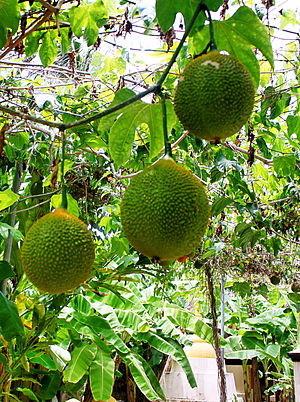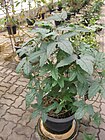Note: This is a project under development. The articles on this wiki are just being initiated and broadly incomplete. You can Help creating new pages.
Difference between revisions of "Momordica cochinchinensis"
(Created page with "{{stub}} ==Uses== {{Uses|}}, {{Uses|}}, {{Uses|}}, {{Uses|}}, {{Uses|}}, {{Uses|}}, {{Uses|}}, {{Uses|}}, {{Uses|}}, {{Uses|}}, {{Uses|}}.<ref name="Uses"/> ==Parts Used== {{...") |
|||
| (2 intermediate revisions by 2 users not shown) | |||
| Line 1: | Line 1: | ||
| − | + | [[File:Quả gấc VN.jpg |thumb|right|'''Momordica cochinchinensis''']] | |
| + | '''Momordica cochinchinensis''' is a type of perennial melon grown throughout Southeast Asian countries and Northeastern Australia. Gấc is notable for its orange-reddish color resulting from its rich content of beta-carotene and lycopene. | ||
==Uses== | ==Uses== | ||
| − | {{Uses|}}, {{Uses|}}, {{Uses|}}, {{Uses| | + | {{Uses|Wounds}}, {{Uses|Skin infections}}, {{Uses|Burns}}, {{Uses|Healing of wounds}}. |
==Parts Used== | ==Parts Used== | ||
| − | {{Parts Used|}}, {{Parts Used| | + | {{Parts Used|Fruits}}, {{Parts Used|Leaves}}. |
==Chemical Composition== | ==Chemical Composition== | ||
| − | <ref name="chemical composition"/> | + | Gac fruit, seeds, and seed oil contain substantial amounts of beta-carotene and lycopene which collectively impart the characteristic red-orange color to the fruit's tissues.<ref name="chemical composition"/> |
==Common names== | ==Common names== | ||
| − | {{Common names | + | {{Common names|kn=|ml=Kshudramalakasanda|sa=Katamala|ta=|te=Varivalli|hi=Kakur, Kantola|en=Chinese Cucumber, Spiny bitter-cucumber}} |
==Properties== | ==Properties== | ||
Reference: Dravya - Substance, Rasa - Taste, Guna - Qualities, Veerya - Potency, Vipaka - Post-digesion effect, Karma - Pharmacological activity, Prabhava - Therepeutics. | Reference: Dravya - Substance, Rasa - Taste, Guna - Qualities, Veerya - Potency, Vipaka - Post-digesion effect, Karma - Pharmacological activity, Prabhava - Therepeutics. | ||
===Dravya=== | ===Dravya=== | ||
| + | |||
===Rasa=== | ===Rasa=== | ||
| − | |||
===Guna=== | ===Guna=== | ||
| Line 29: | Line 30: | ||
==Habit== | ==Habit== | ||
| − | {{Habit|}} | + | {{Habit|Herbs}} |
==Identification== | ==Identification== | ||
===Leaf=== | ===Leaf=== | ||
| − | {{Leaf|||}}<ref name="Leaf"/> | + | {{Leaf|Simple|Round in outline|1.5-5.0 cm long and as broad, heart-shaped at base, hairless or sparsely hairy, 3-5-lobed, middle lobes broadly ovate or rhombic-ovate}}<ref name="Leaf"/> |
===Flower=== | ===Flower=== | ||
| − | {{Flower||||}} | + | {{Flower|Bisexual|Broadly ovate-heart-shaped|Cream white||2.5-3.0 cm across, stalked. Male flowers are solitary, on 1.5 cm long flower-cluster-stalk, bearing near the tip a stalkless}} |
===Fruit=== | ===Fruit=== | ||
| − | {{Fruit|||| | + | {{Fruit|Simple Fruit|Ovoid|2-7 cm long, 1-2.5 cm broad|Orange-red|}} |
===Other features=== | ===Other features=== | ||
| Line 46: | Line 47: | ||
==Where to get the saplings== | ==Where to get the saplings== | ||
| − | |||
==Mode of Propagation== | ==Mode of Propagation== | ||
| − | {{Propagation|}} | + | {{Propagation|Seeds}}. |
==How to plant/cultivate== | ==How to plant/cultivate== | ||
| − | <ref name="How to plant/cultivate"/> | + | Maximum insect-aided pollination, the recommended ratio is about 1 male for every 10 female plants.<ref name="How to plant/cultivate"/> |
==Commonly seen growing in areas== | ==Commonly seen growing in areas== | ||
| − | {{Commonly seen| | + | {{Commonly seen|Lowland forest}}. |
==Photo Gallery== | ==Photo Gallery== | ||
<gallery class="left" caption="" widths="140px" heights="140px"> | <gallery class="left" caption="" widths="140px" heights="140px"> | ||
| − | + | File:Exterior and cross-sectional interior of gac.jpg | |
| + | File:Flore des serres v14 227a.jpg | ||
| + | File:Gac Fruit.jpg | ||
| + | File:Gardenology.org-IMG 8003 qsbg11mar.jpg | ||
</gallery> | </gallery> | ||
==References== | ==References== | ||
| + | |||
<references> | <references> | ||
| + | <ref name="chemical composition">[https://en.wikipedia.org/wiki/Gac Chemical composition]</ref> | ||
| − | <ref name=" | + | <ref name="Leaf">[http://www.flowersofindia.net/catalog/slides/Chinese%20Cucumber.html Morphology]</ref> |
| − | + | <ref name="How to plant/cultivate">[https://en.wikipedia.org/wiki/Gac#cite_note-:5-5 Cultivation Details]</ref> | |
| − | |||
| − | <ref name="How to plant/cultivate">[ | ||
| − | |||
</references> | </references> | ||
==External Links== | ==External Links== | ||
| − | * [ ] | + | * [http://www.flowersofindia.net/catalog/slides/Chinese%20Cucumber.html Momordica cochinchinensis on flowersofindia.net] |
| − | * [ ] | + | |
| − | + | * [https://en.wikipedia.org/wiki/Gac Momordica cochinchinensis wikipedia.org] | |
| + | |||
| + | |||
[[Category:Herbs]] | [[Category:Herbs]] | ||
| + | [[Category:Cucurbitaceae]] | ||
Latest revision as of 15:05, 24 June 2020
Momordica cochinchinensis is a type of perennial melon grown throughout Southeast Asian countries and Northeastern Australia. Gấc is notable for its orange-reddish color resulting from its rich content of beta-carotene and lycopene.
Contents
- 1 Uses
- 2 Parts Used
- 3 Chemical Composition
- 4 Common names
- 5 Properties
- 6 Habit
- 7 Identification
- 8 List of Ayurvedic medicine in which the herb is used
- 9 Where to get the saplings
- 10 Mode of Propagation
- 11 How to plant/cultivate
- 12 Commonly seen growing in areas
- 13 Photo Gallery
- 14 References
- 15 External Links
Uses
Wounds, Skin infections, Burns, Healing of wounds.
Parts Used
Chemical Composition
Gac fruit, seeds, and seed oil contain substantial amounts of beta-carotene and lycopene which collectively impart the characteristic red-orange color to the fruit's tissues.[1]
Common names
| Language | Common name |
|---|---|
| Kannada | |
| Hindi | Kakur, Kantola |
| Malayalam | Kshudramalakasanda |
| Tamil | |
| Telugu | Varivalli |
| Marathi | NA |
| Gujarathi | NA |
| Punjabi | NA |
| Kashmiri | NA |
| Sanskrit | Katamala |
| English | Chinese Cucumber, Spiny bitter-cucumber |
Properties
Reference: Dravya - Substance, Rasa - Taste, Guna - Qualities, Veerya - Potency, Vipaka - Post-digesion effect, Karma - Pharmacological activity, Prabhava - Therepeutics.
Dravya
Rasa
Guna
Veerya
Vipaka
Karma
Prabhava
Habit
Identification
Leaf
| Kind | Shape | Feature |
|---|---|---|
| Simple | Round in outline | 1.5-5.0 cm long and as broad, heart-shaped at base, hairless or sparsely hairy, 3-5-lobed, middle lobes broadly ovate or rhombic-ovate |
Flower
| Type | Size | Color and composition | Stamen | More information |
|---|---|---|---|---|
| Bisexual | Broadly ovate-heart-shaped | Cream white | 2.5-3.0 cm across, stalked. Male flowers are solitary, on 1.5 cm long flower-cluster-stalk, bearing near the tip a stalkless |
Fruit
| Type | Size | Mass | Appearance | Seeds | More information |
|---|---|---|---|---|---|
| Simple Fruit | Ovoid | 2-7 cm long, 1-2.5 cm broad | Orange-red | {{{6}}} |
Other features
List of Ayurvedic medicine in which the herb is used
Where to get the saplings
Mode of Propagation
How to plant/cultivate
Maximum insect-aided pollination, the recommended ratio is about 1 male for every 10 female plants.[3]
Commonly seen growing in areas
Photo Gallery
References
External Links
- Ayurvedic Herbs known to be helpful to treat Wounds
- Ayurvedic Herbs known to be helpful to treat Skin infections
- Ayurvedic Herbs known to be helpful to treat Burns
- Ayurvedic Herbs known to be helpful to treat Healing of wounds
- Herbs with Fruits used in medicine
- Herbs with Leaves used in medicine
- Herbs with common name in Hindi
- Herbs with common name in Malayalam
- Herbs with common name in Telugu
- Herbs with common name in Sanskrit
- Herbs with common name in English
- Habit - Herbs
- Index of Plants which can be propagated by Seeds
- Herbs that are commonly seen in the region of Lowland forest
- Herbs
- Cucurbitaceae




